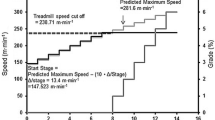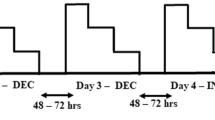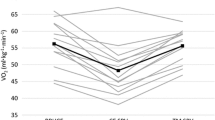Abstract
The present investigation was undertaken to examine whether maximal oxygen uptake (\( \dot V{\rm O}_{{\rm 2max}} \) ) and anaerobic threshold (AT) measured during incremental treadmill exercise would be affected by the exercise protocol in trained and untrained individuals. Fifteen untrained men, 10 untrained women, and 12 trained individuals participated in this study. The Åstrand, Bruce, and Costill/Fox protocols were selected for comparison. Each subject was tested using all three protocols and the three tests were conducted in a randomized counterbalanced order. During each test, oxygen uptake was measured every 30 s and the test was terminated according to the standard criteria. The \( \dot V{\rm O}_{{\rm 2max}} \) was determined by averaging the two consecutive highest measurements, whereas AT was determined using ventilatory parameters following the V-slope technique. The Åstrand, Bruce, and Costill/Fox protocols produced test durations of 9.8 (SEM 0.5), 12.4 (SEM 0.4), and 4.9 (SEM 0.3) min, respectively, in the untrained men, 9.0 (SEM 0.8), 11.0 (SEM 0.6), and 5.3 (SEM 0.6) min, respectively, in the untrained women, and 14.5 (SEM 0.5), 17.0 (SEM 0.5) and 10.4 (SEM 0.4) min, respectively, in the trained men. In the untrained men and women, no differences in \( \dot V{\rm O}_{{\rm 2max}} \) were observed among the three different protocols, but AT was lower when using the Bruce compared to the Åstrand protocol. In the trained men, \( \dot V{\rm O}_{{\rm 2max}} \) and AT were lower when using the Bruce protocol than either the Åstrand or Costill/Fox protocols. In conclusion, \( \dot V{\rm O}_{{\rm 2max}} \) measured during treadmill exercise is not affected by the protocol of the test and using a running protocol of short duration (i.e. about 5 min) could be a time-efficient way of assessing \( \dot V{\rm O}_{{\rm 2max}} \) in healthy untrained subjects. In trained subjects, however, a protocol consisting of running with small increments in gradient is effective in eliciting a higher \( \dot V{\rm O}_{{\rm 2max}} \) . The lower AT associated with the Bruce protocol seen in both untrained and trained groups suggests this aerobic parameter is protocol dependent and this protocol dependency is not affected by training status.
Similar content being viewed by others
Author information
Authors and Affiliations
Additional information
Electronic Publication
Rights and permissions
About this article
Cite this article
Kang, J., Chaloupka, E., Mastrangelo, M. et al. Physiological comparisons among three maximal treadmill exercise protocols in trained and untrained individuals. Eur J Appl Physiol 84, 291–295 (2001). https://doi.org/10.1007/s004210000366
Accepted:
Published:
Issue Date:
DOI: https://doi.org/10.1007/s004210000366




